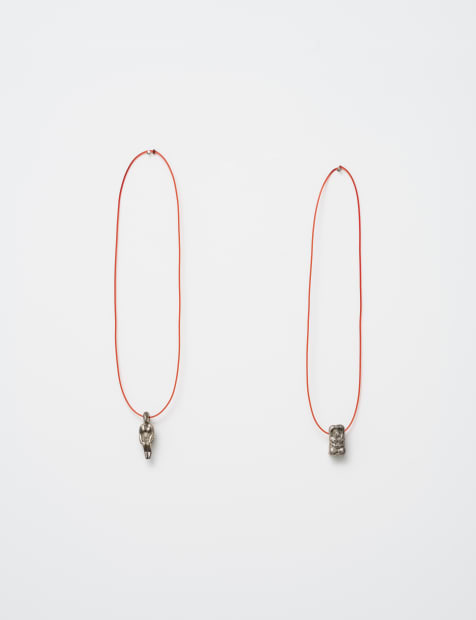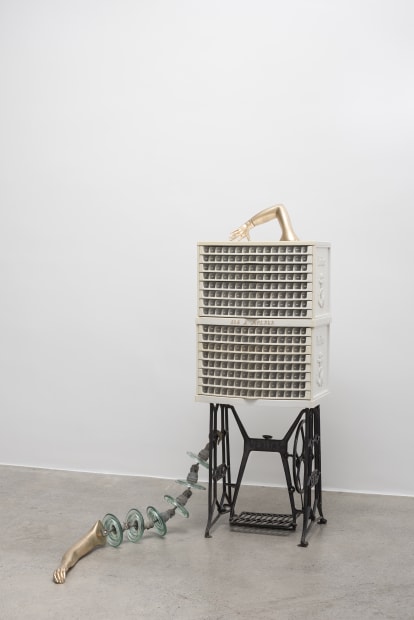-
-

-
A Festa (2017)
Despite being made a few years ago, the painting A Festa (2017) by Marepe took on new meanings after the global experience of Covid-19 pandemic: according to the artist, a party that takes place inside an apartment, where only a couple attend and, therefore celebrate as a family in the confined environment of the home. It is a portrait of what would become the normality of a possible party: only individuals from the same circle of daily living in an isolated and domestic environment. "My relationship with my home has changed a lot during these months of confinement. Just as it must have happened to a lot of people, I needed to get back to domestic chores that I didn't have to worry about before, since we no longer had help at home. And that turning towards the house, dwelling on the minutiae of domesticity, the smallest details and corners of our own habitat, awakened new ways of seeing this environment. I discovered so much about my house and today I can say that I know it better than ever", says Marepe.
-

-

-
Contatos espaciais (2020)
Entitled Contatos Espaciais (2020), the work represents cocoons (or shells) with antennae, symbolizing the type of contact that marked the day-to-day lives of most people in 2020. The song Parabolicamará, by Gilberto Gil, describes the ultimate consequences – in real life – of what it once meant to have a satellite dish: “Before the world was small / Because the earth was large / Today the world is very large / Because the earth is small / The size of the antenna…”. Our planet became tiny, the size of a shell, hyperconnected via Zoom and viewing rooms.
-
-
Untitled (2017)
Admittedly abstract, the Untitled drawings group (2017) is part of Marepe's recurrent investigations of the collage tradition. Since Braque and Picasso, modern art began to walk in the hybrid between traditional languages and collage, deriving from this genesis (at least in the canonical narrative of Western art) a whole universe of “expansion” in the field of art. In this 2017 series, Marepe mixes collage, drawing and ink with freedom and coherence, imagining - above all due to the silver shine of the adhesive tape he chose to give unity to the ensemble - a future for art that is pregnant with the past and, without any paradox, post-futurism. The ink appears through its iconic stamps developed to portray life in the hinterland of Bahia (Carimbó series, 2007).
-

-

-
Olhar encarcerado, Óculos (2008)
Olhar Encarcerado (2008), also an unseen work, provokes our understanding about the vision. It is a giant pair of glasses with the "lens" composed by steel cables that do not allow access to the other side, only a fragmented look that suggests the difficulty of seeing. The piece requires a displacement of the body to be apprehended and symbolically mimics the impediment to move, the impossibility of looking, the limitation of traveling to see the world. For Marepe, the work holds new meaning with the pandemic, hence the decision to include it in the exhibition as a counterpoint to the canvas A Festa, which also deals with new ways of looking at the present time.
-

-
Sem título (2020)
Marepe creates his collages as he builds his assemblages (read that a significant part of his sculptural work is thought of as three-dimensional collage): collecting and selecting fragments of the world to build new narratives about the world. Using the parts as raw material to narrate the whole has something of the Dadaist tautology to attest to the irrationality of civilization. The artist has very different series of collages. In this group, Sem Título (2020), which is a sequence of previous works, Marepe flirts with surrealism by making the observer strange and, therefore, reviewing elements and images that seemed familiar or commonplace, but are not.
-

-

-
Conexões protetoras (2020)
Pipes are not an unprecedented material in Marepe's work, who has used pipes and tubes in previous works, in general as an allusion to the universe of domesticity. Protective Connections (2021) has a shape that refers to that of a habitable structure, as if it were the architectural skeleton of an improvised shelter. The artist investigates aspects of vernacular urbanism, from the Embutidos series, in which he proposed the utopia of a portable house, from the beginning of his trajectory, to the group of works that bears the name of Buildings, made from the stacking of plastic household utensils. The game of scale is the key to understanding the work, because what Marepe proposes with the Buildings is the opposite of the utopia of its Embedded (Embutidos): return to the monumental scale (of a building, for example, but in proportions closer to the building model) ) the small plastic containers used to pack or facilitate the little things of everyday life (ice cream, soap dish, dish rack, baby seat, pots, vases, beach toys, pet feeder and trinket holder in general) that flood the dystopian world of advanced capitalism. A work of maturity, Conexões Protetoras protects itself beyond the dichotomy of utopian and dystopian works, because in it Marepe simplifies the building, as well as its content, which is summed up in a stainless steel chair on which rests a glass globe, evoking the protection of actions and attitudes based on solidarity.
-

-

-
playlist
As Marepe often uses readymade materials and everyday objects or activities, his work has acquired a complex layering of references and meanings.‘At a time of global cultural homogenization his works carry an exceptional way of authenticity, talking about the unique cultural particularities of the place he calls home - Bahia, proposing an argument that is generally understandable. The attraction of his works lays in its exotic nature that speaks to the fusion of cultures of which he is a witness.’ (Excerpt of the text ‘Cannibalisation of the Day-to-day’ by Jens Hoffman).





















